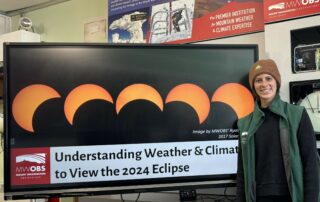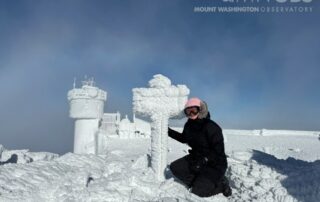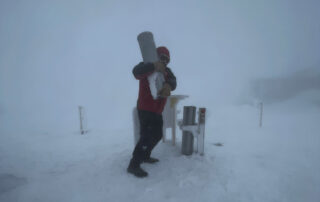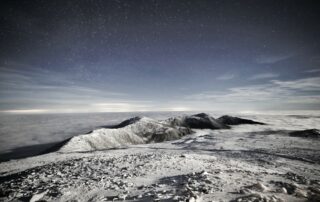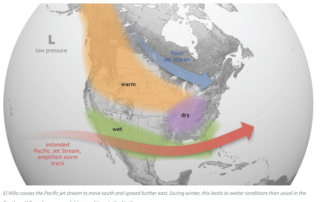Mount Washington Observatory Observer Blog
Meet Seek the Peak Steward Chris Nichols
Meet Seek the Peak Steward Chris Nichols By MWOBS Staff Mount Washington Observatory’s largest fundraising event, Seek the Peak, has long encouraged participants to seek their peak by picking a walk in the woods of their choosing, whether in the White Mountains or their backyard, while raising funds for the organization's research, education, and everyday operations. It is a great honor and pleasure to learn about the individuals who make this event an immense success year after year and the stories behind their involvement. For some, it is about getting together with friends and family in the great Granite
A Closer Look at Lenticular Clouds
A Closer Look at Lenticular Clouds By Karl Philippoff I grew up in New Jersey, and while that was great for many reasons, one of the things my home state is missing is large mountains, both to recreate in and to see from afar. Living on top of New England’s tallest mountain for 8 days at time has served to replace this something that was missing and then some! One of the attractions of living up here is to be at an excellent viewpoint to have bird’s eye view of the clouds (when we are not in fog, of course)
Meet MWOBS/MWAC Intern Laura Wilson
Meet MWOBS/MWAC Intern Laura Wilson By Laura Wilson Hi! I’m Laura Wilson, the winter intern for both the Mount Washington Observatory and the USFS Mount Washington Avalanche Center, and I am so stoked to be up here! Growing up in Maine, I’ve always had a fascination with the nearby White Mountains. It’s a dream come true to live at the summit throughout all the incredible winter conditions. During high school, I attended Gould Academy in Bethel, ME and spent a great deal of time training as a biathlete in nearby Jackson NH. My fondest memories are of foliage filled
MWOBS’ Education Team Launches Virtual Programs for the 2024 Solar Eclipse
MWOBS’ Education Team Launches Virtual Programs for the 2024 Solar Eclipse By Alex Branton We are just 9 weeks away from the Great American Eclipse of 2024, and the Mount Washington Observatory is preparing for the event by offering new education programs. This year on Monday, April 8th, all of North America will have the opportunity to view at least a partial solar eclipse. The path of total solar eclipse will pass over northern New England, while the rest of the region will experience at least a 90% obscuration of the sun by the moon. While most of the
Remembering Marty
Remembering Marty By Ken Rancourt | January 25, 2024 Known throughout New England as "Marty on the Mountain," Marty Engstrom passed away on Jan. 4 at his home in Fryeburg, ME, according to his family. He was 86 years old. Engstrom worked for 38 years on Mount Washington as an engineer at the WMTW transmission station; he wrote about his experiences in his 2003 book titled “Marty on the Mountain: 38 Years on Mount Washington.” Marty was already on the Mountain for over ten years when I met him in the fall of 1979. Guy Gosselin's (Obs Director) assistant,
Living in Winter Wonderland
Living in a Winter Wonderland By Tricia Hutton Hi! I’m Tricia, an intern at Mount Washington Observatory. I am just a few days into my internship at MWO and it has already exceeded all my expectations and dreams. Every day I have stated that it cannot get better than this—and day after day I am amazed. I am beyond thankful that this is just the beginning. I cannot believe I have the opportunity to come back up to the Observatory at shift change every other week through May. My first few days consisted of near-zero visibility, but I found
An Observer Reflects on 2023
An Observer Reflects on 2023 By Francis Tarasiewicz 2023 will undoubtedly go down in history as a year marked by extraordinary occurrences. From prolonged periods of intense warmth pushing the planet beyond the critical 1.5°C threshold to instances of flooding, wildfires, and unexpected polar vortex intrusions, the past year was a rollercoaster of meteorological phenomena for Earth's inhabitants. At the Home of the World’s Worst Weather, where resilience in the face of extremes is a way of life, we embrace weather that tests our limits. For more than 90 years, the summit has attracted scientists positioned between thrill-seekers and
2023 By The Numbers
2023 by the Numbers By Ryan Knapp January has arrived, a time to not only look forward to what might occur in the coming year, but also look back and reflect on the previous year. Looking back at weather stats, I would summarize 2023 weather conditions on the summit as warm, wet (but not snowy), and foggy. To find out why I've chosen these words, let's look back at some of the stats from 2023. Our average temperature for 2023 was 30.4°F (-0.9°C), which is 2.4°F above the 1991-2020 30-year normal for our station. This would make the annual
Snow on the Way
Snow on the Way By Alexis George After a December to remember (or forget, depending on your preferred weather), in which much of the Northeast experienced warm temperatures and a snowfall deficit, it finally looks like snow is on the way! A strong El Nino pattern has had a major impact on weather conditions across the Northeast and will continue to affect weather conditions going forward this winter. El Nino causes the Pacific jet to move south and then spread farther east of its neutral position. This can lead to a slow start to the winter, with the Northeast
The Shared History of AMC and the Mount Washington Observatory
The Shared History of AMC and the Mount Washington Observatory By Matt Morris | December 13, 2023 Courtesy of the Mount Washington Observatory Library. April 11, 1934: It was relatively warm on the summit of Mount Washington. Below freezing, but not by much. But more comfortable temperatures were not a reason for relief for the staff of the Mount Washington Observatory. Two walls of the Observatory building were caked in ice nearly a foot deep and the wind was picking up. The observers decided to stay up in shifts that night, taking measurements with a radio to
Search with Text




